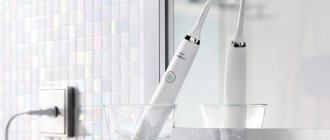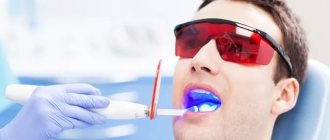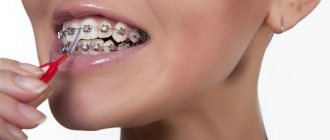There are a huge number of electric brushes on the market, which differ from each other in their operating principles and functions. Ultrasonic brushes are considered the most modern. They operate on the basis of ultrasonic waves that are transmitted from the device to the person during cleaning. We'll tell you how to brush your teeth with this brush.
An ultrasonic toothbrush uses ultrasonic waves to cleanse teeth from food debris and plaque. This device consists of a handle with a battery or battery, a body equipped with a high-frequency generator, and a head with bristles, like a regular toothbrush.
In this article
- Working principle of an ultrasonic toothbrush
- Ultrasonic brush: indications and contraindications
- Ultrasonic brush: pros and cons
- How to brush your teeth with an ultrasonic brush
- How to choose an ultrasonic brush
- How to care for an ultrasonic toothbrush
Ultrasound devices are the most modern and functional. They provide maximum cleansing of the oral cavity, including interdental spaces, and removal of plaque and deposits. With this device, many dental diseases can be prevented. Let's talk about the features of ultrasonic brushes and learn how to properly brush your teeth with them.
Working principle of an ultrasonic toothbrush
When using an ultrasonic brush, teeth are cleaned using both bristles and high-frequency waves. The bristles clean the enamel from surface contaminants, just like a regular toothbrush. You just don’t need to put pressure on your teeth or rub them with the device. It is necessary to move the head from one part of the jaw to another, lingering in each area for a few seconds.
Ultrasonic waves created by the device penetrate deep into deposits, destroying them from the inside. They are separated from the enamel and washed out of the mouth. At the same time, the mouth is cleansed of germs. You may feel warm while cleaning. As a result of an increase in temperature by 1°, blood flow in soft tissues is stimulated, as with a light massage, which reduces their sensitivity and prevents the development of gingivitis. In addition, calcium and fluoride ions are released from toothpaste, which strengthen the enamel.
Using an ultrasonic brush, you can maintain oral hygiene without resorting to other means: balms, dental floss, etc.
Differences between electric toothbrushes
Experts say that when choosing between manual and electric brushes, you should take the second option. It will provide better care for your gums and teeth.
The advantages of the electrical appliance include the following:
- saving time. The time it takes to brush your teeth is reduced to 2 minutes. At the same time, the quality of hygiene does not deteriorate;
- simplifying the process. You don't need to make any special movements or put in any effort. It is enough to guide the electrical appliance with your hand, and it will do the cleaning itself;
- saving pasta. It is not necessary to apply gel or paste to an electric toothbrush to deal with plaque on your teeth. If a person is still accustomed to the paste, then only a small amount of it should be applied to the electric brush;
- high cleaning efficiency. Here the bristles vibrate as they move over the surface of the teeth. This allows you to destroy plaque and remove it in areas that are considered difficult to reach;
- gum massage Bristles. Which rotate, cannot injure. They guarantee a delicate massage for the gums, which helps strengthen the tissues and improve blood circulation in them.
Ultrasonic brush: pros and cons
Brushing your teeth with an ultrasonic brush is useful for the following reasons:
- removes bacteria from the mouth;
- destroys plaque;
- suitable for sensitive gums and enamel;
- compatible with braces and dentures;
- stimulates blood circulation.
There are practically no disadvantages to such devices, except for the presence of contraindications and high price. However, you can use one brush with your whole family if everyone has their own brush head. Accessories must be purchased separately. In addition, any doctor will tell you that it is better not to skimp on oral hygiene. We'll tell you how to properly brush your teeth with an ultrasonic brush.
Advantages
Professional dentists note the following advantages of the products compared to conventional analogues:
- no risk of enamel damage;
- reduction of bleeding gums;
- the ability to clean not only the surface of the teeth , but also the tongue, as well as the mucous surface of the oral cavity;
- destruction of bacteria and pathogens present on the enamel;
- acceleration of biochemical processes and activation of blood circulation in the oral cavity due to heating of soft tissues during the use of an ultrasonic brush;
- antibacterial protection due to the effect of ultrasound on the deep layers of oral tissue;
- the ability to lighten the enamel by 1 - 2 tones with regular use of the brush together with whitening paste or powder;
- high efficiency in cleaning fixed orthodontic structures;
- pain relief due to the influence of ultrasonic waves;
- short duration of teeth cleaning compared to conventional brushes.
The video shows how to use the devices and explains their benefits.
How to brush your teeth with an ultrasonic brush
You need to learn how to use any toothbrush, otherwise it will be of no use. In addition, there is a risk of injuring soft tissues or enamel. Read the instructions before using the device. To properly brush your teeth with an ultrasonic electric brush, you need to follow the following algorithm:
- select the appropriate operating mode;
- rinse the bristles with water;
- apply a little paste on them;
- bring the brush to the front row of teeth at an angle of 45°;
- carefully move the head along the jaw without pressing on it;
- brush each tooth for 3-4 seconds;
- Rinse your mouth with water and wash your brush.
The duration of the procedure is 2-3 minutes. Some devices have a timer that alerts you when you need to move to the next quadrant of the jaw or finish brushing.
Depending on the specific model, the device can operate in several modes. They differ in the number of movements of the bristles. At the very beginning, choose a mode with minimal vibration intensity. When switching them, turn off the device.
Design features and principle of operation
An ultrasonic brush belongs to the category of electrical devices. It contains a small motor located inside the volumetric handle, and a piezoceramic plate, which is located under the bristles of the device. The operating principle of the device is as follows:
- when the motor is turned on, the plate emits ultrasonic waves with an oscillation frequency of 1.7 MHz;
- as a result, the bristles begin to vibrate, making about a hundred million movements within a minute;
- The ultrasonic wave affects the tooth surface and adjacent tissues, which leads to softening, mobility of plaque and its elimination.
The difference between an ultrasonic brush and conventional sound analogues is the frequency range. The sound product generator has a frequency within 30 kHz, which implies 30 thousand movements of the bristles per minute during use.
The products have a frequency range of 1.6 - 1.7 MHz, so the number of movements of the bristles reaches 100 million.
The penetration depth of the wave reaches 4 mm, due to which it affects not only dental but also periodontal tissue. Thanks to the deep penetration of the waves, the gum canal is also cleaned of various deposits and plaque.
Ultrasound penetrates into hard-to-reach places in the oral cavity: the interdental space and remote areas of the last molars, effectively cleaning them from soft and hard plaque.
During use of the device, heat is transferred to the tissues of the oral cavity. Thanks to this process, the release of calcium and fluoride ions from toothpaste is accelerated, which strengthens the enamel, activates blood circulation in the gums and regeneration of the mucous membrane.
The difference between an ultrasonic brush and conventional sound analogues is the frequency range. The generator has a frequency of 30 kHz, which implies 30 thousand movements of the bristles per minute during use.
Depending on the manufacturer and model, the device can be powered by mains power or rechargeable batteries or regular batteries.
See photos of dental fluorosis and the consequences of ignoring treatment. This section talks about Astra Tech implants, their features and advantages.
Follow the link https://dr-zubov.ru/ortodontiya/apparaty/plastiny/bryuklya-kogda-trebuetsya.html to find out what the Bruckle apparatus is and in what cases its use is necessary.
How to choose an ultrasonic brush
When buying an electric toothbrush, pay attention to the following parameters:
- Number of modes. The more there are, the safer and better the device cleans the oral cavity.
- Pressure sensor. If you press hard on your teeth with the brush, the device will automatically turn off.
- Timer. It makes it easier to get used to brushing your teeth with an electric brush. It is advisable to buy models with timers for children.
It is also necessary to choose the right nozzle. There are several types of ultrasonic toothbrushes available:
- MB1 (soft) - a nozzle with soft bristles of a zigzag shape. It is suitable for children, people with hypersensitivity of enamel and gums, as well as for pathologies of the soft tissues of the oral cavity.
- MB2 (medium) - a brush with medium-hard bristles in a zigzag shape. It can be used by all people with healthy teeth and gums.
- MB5 (soft) - a nozzle with soft bristles of equal height. It is better to choose it if there is bleeding gums, as well as after dental operations.
- MB6 (medium) - a brush with medium-hard bristles with equal hairs along the entire length. It is recommended for people with crowns and veneers.
There are not as many ultrasonic models today as standard and sound ones. Our online store presents a series of Emmi-Dent ultrasonic electric brushes. They operate on batteries and can hold a charge for 20 days.
Disadvantages and contraindications for use
Before purchasing and using an electric toothbrush, you should consult your dentist. It is contraindicated for certain people and can even harm their teeth. It is not recommended to use an electric toothbrush:
- People with obvious defects and damage to teeth;
- People with serious types of caries;
- For those with thin and sensitive enamel;
- For wearers of veneers, crowns or other structures;
Don’t forget about regularly changing the attachments for your electric brush. This should be done every 3-6 months.
Read us on Yandex Zen: What you need to know about electric toothbrushes?
How to care for an ultrasonic toothbrush
Such devices are quite expensive, so they need to be carefully looked after so that they last as long as possible. After each procedure, rinse the bristles to remove food debris and bacteria. You can pour boiling water over the head or periodically rinse it in a disinfectant solution. Keep the device in a place protected from water. Do not allow moisture to get on the motor, as it may burn out. Do not charge your device in the bathroom. It is better to do this in the room or kitchen.
Every 3-4 months it is necessary to change the attachments. Over time, they delaminate, move apart and soften. It is not safe to use such a brush. Some models have a wear indicator - blue bristles. Over time, they fade, which indicates the need to throw away the old attachment and connect a new one to the device.
Types of electric brushes
Modern electrical appliances are divided into 3 types:
- mechanical. It has a round head and contains two main elements - nozzles and a holder. These brushes are distinguished by their affordable price and high-quality cleaning. Can be used for people who have high tooth sensitivity and those who wear braces;
- sound. The head shape here is longer, and cleaning is carried out due to sound vibrations. Such devices can make up to 48 thousand rotations per minute. Sonic electric brushes do an excellent job of removing hard-to-reach areas, dirt, plaque, do not harm the enamel, provide a delicate massage for the gums, prevent bleeding, and restore blood circulation in the tissues. These brushes can be used when wearing crowns, braces, or veneers. After brushing, the teeth are perfectly polished;
- ultrasonic. Such devices are distinguished by slight vibration of the bristles, but at the same time they can perform 204 million movements in a minute. Such brushes have their own peculiarity - they deeply affect the tissues, guarantee high hygiene efficiency and excellent gum massage.
A little bit of history
If the history of a regular toothbrush goes back more than a million years, then its electric version appeared relatively recently, in 1954, in Switzerland. Thanks to the ingenuity of Dr. Philippe Guy Voog, the world learned about the first corded toothbrush under the Broxodent brand. This device was mainly used by patients with hand motor disorders or those who corrected their bite with braces. However, already in the early 60s, General Electric introduced a cordless, battery-powered toothbrush that anyone could use. Over the next decades, perhaps, only the lazy did not conduct experiments on this device. Until 1998, about three thousand electric models were patented. The development of this indispensable device continues to this day. Innovative brushes of the latest generations can clean teeth in 10 seconds or teach children the rules of hygiene while listening to music. I wonder what miracle devices await us in the near future?









